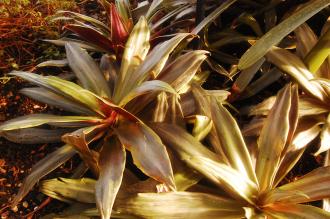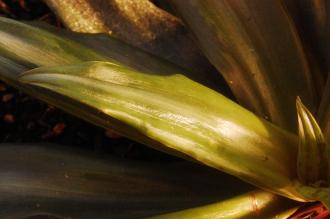
Tradescantia spathacea (16/01/2016, Kew Gardens, London)
Position: Full sun to partial shade
Flowering period: All year round
Soil: Moist, well drained
Eventual Height: 30cm
Eventual Spread: 50cm
Hardiness: 9b, 10a, 10b, 11
Family: Commelinaceae
Tradescantia spathacea is an evergreen herbaceous perennial with a clump forming habit. Its glossy dark green leaves are lanceolate with entire margins, purple on their undersides, up to 30cm long and 7cm across. Its white flowers are 3 petalled and emerge from purple bracts. Its roots have fleshy rhizomes which aids its spread.
Tradescantia spathacea, commonly known as Boat Lily or Moses In The Cradle, Christ In The Cradle and Oyster Plant, is native to south Mexico and Central America. In its native habitat it grows as a woodland understory plant in sub tropical and warm temperate regions. This species of plant is considered to be invasive in parts of the USA. This plant may cause dermal irritation in some people.
The etymological root of the binomial name Tradescantia is named after John Tradescant (1608-1662) who served as gardener to Charles 1 of England. Spathacea is derived from the Greek spaqh meaning ‘broad blade’, in reference to the spathes which enclose this plants flowers.
The landscape architect may find Tradescantia spathacea useful as an evergreen house plant with lush tropical foliage. Once established this plant is drought tolerant.

Tradescantia spathacea Leaf (16/01/2016, Kew Gardens, London)
Ecologically, Tradescantia spathacea flowers are attractive to some pollinating insects.
The Royal Horticultural Society have given the variety Tradescantia spathacea ‘Vittata’ their prestigious Award of Garden Merit in 1993.
Tradescantia spathacea prefers moist, fertile, well-drained soils. It tolerates most pH of soil.
When maintaining Tradescantia spathacea as a houseplant its soil should be watered regularly (but not wet). Watering should be reduced during the winter months. Its preferred active growing temperature rages from between 18ºc to 27ºc, although it will tolerate temperatures as low as 0ºc. Feeding with weak fertiliser solution should be carried out once a month during the growing season. Mealy Bugs, Scale Insects, Whiteflies and Red Spider Mites may attack this plant. To keep a tidy appearance this plant may be pruned in spring.

Landscape Architecture

